Updated: 30-Jun-2021
Laviator made 2-stroke rotary engines as from 1910. They were 3-cylinder radial rotary engines. The first of them had a rotation of about 1000 rpm, therefore it was a 2-stroke engine. There were three explosions per revolution.
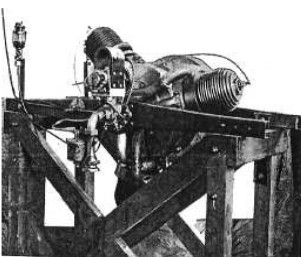

“Laviator 3-cylinder rotary”
-We have another photograph, with more detail and another diagram of the 3-cylinder.
-The displacement is obtained by the dimensions of its cylinders, 100 mm bore by 110 mm stroke.
-The pistons are double-working for the sweep, as with the Prini et Berthaud of the same time. (see Berthaud).

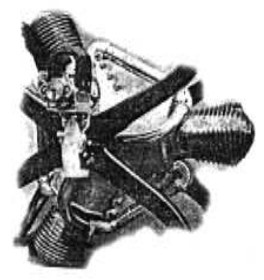
“Another version of the 3-cylinder engine”
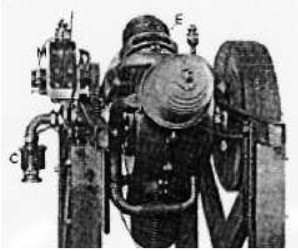
“Laviator 3-cylinder rotary”
-The 3 cylinder shown here gave 50 CV at 1,100 rpm. On the left the magneto and the carburetor.
-A kind reader sent us some photographs and a drawing of the Laviator three-cylinder engine, which in the main text does not appear too clear.

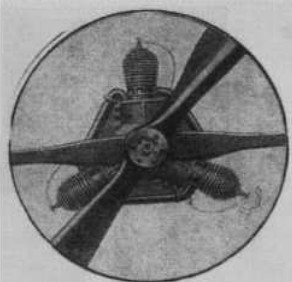
"Rear and front views of the 3 cylinder Laviator"
-As advertised in their best years, Laviator produced engines for Airplanes, Hydroplanes and Airships (in addition to industrial and marine engines).
-The offices were in Paris and the factory was in Suresnes.
-They mass produced the Dansette-Gillet engines.
-At some point in this publication it is said that "the function creates the organ" referring to the need of each part of an engine and with a hint to the mentality of the officials.
-We now see a variant that was the main reason for the Laviator company: “Adaptation of the organ to the function”.
-It is surprising to know the range of manufactured aviation engines, thus having a line of 2-stroke 3-cylinder radial rotaries, 2-stroke 6-cylinder fixed radials, 4 and 6 cylinder in-line, and 8-cylinder Vee-engines. We therefore have:
-Fixed radial engines with fins (air cooled), a 65 CV at 1,200 rpm.

“Laviator 6-cylinder engine”
-We can see the air-cooled six-cylinder Laviator.

“Laviator, air-cooled radial engine”
-The second radial that Laviator built gave 80 CV, also two-stroke, but water-cooled.
-In the lower picture this motor is rotated 90° to the right, being a fixed radial.

“Laviator, 80 CV”

“Laviator water-cooled engine”
-Inlet manifolds are intertwined. In the above six-cylinder engine we also see the coolant ducts. The engine in the lower picture is rotated 90° to the right.
-Now we switch over to the 4-cylinder, upright, in-line engines. They are 4-stroke engines that give 60, 80 and 120 CV.
-These engines have concentric and interchangeable valves. Claudel or Zenith automatic carburetor and magneto ignition with automatic advance.

“Laviator 4-cylinder engine”
-The 6-cylinder, upright, in-line engines were developed from the above mentioned four-cylinders and were offered in two powers: 110 CV and 200 CV.
-Curiously they cost 21,000 and 36,000 Fr. respectively. The powers were obtained at 1,100 rpm the former and 1,050 the latter.
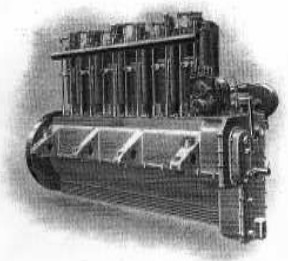
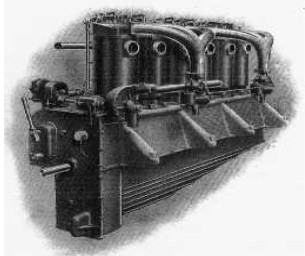
"Two 6-cylinder Laviator in line"
-The 8-cylinder V-engines gave 80 CV at 1,200 rpm.
-The measurements for the cylinders were 100 mm bore x 130 mm stroke.
-The Laviators were made at the Dansette et Gillet factory.

“Laviator V8, 80 CV”
-They had concentric valves and other devices as in the inline engines.
-The 120 CV version was similar but larger, the cylinder measurements were 114 mm bore x 160 mm stroke. Its power was reached at 1,200 rpm.
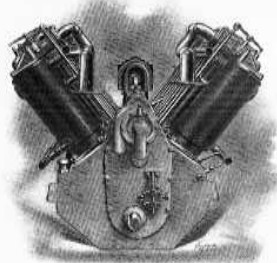
“Laviator, 200 CV, V8”
-Another version, even larger, was the 200 CV engine with 145 mm bore x 175 mm stroke.
-It was a V-8 as well, and its power was obtained at 1,100 rpm.
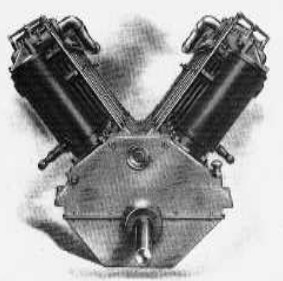
“Laviator 200 CV, V8”
From Appendix 6: We show a new photograph of a Laviator presented at the 1910 Paris Air Show. This engine that is also shown in the main text has three rotating cylinders.
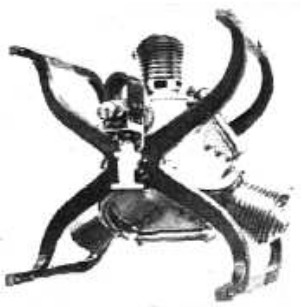
“Laviator from 1910”
-A photo for a 80 CV eight-cylinder Laviator has also recently been acquired. It is little known, and as we can see in the photograph it is from 1913.

“Laviator V-8 engine from 1913”
From Appendix 9: Below we offer a diagram for a Laviator engine, the three cylinder radial rotary, showing its interiors. It has double-working overhead pistons. The lower area "blows" the mixture into the next cylinder. Great.
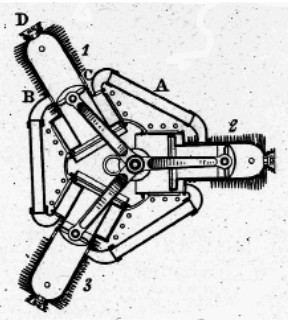
"Cross-section for the 3-cylinder radial rotary"
-Two new photographs of Laviator engines that are not shown in the main text.
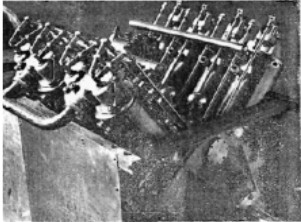
“Laviator V8, 200 CV”

“Laviator radial, 80 CV”
Engines of LAVIATOR
Model: 3 cyl. radial rotary
Arquitecture: 2-stroke3-cylinder Rotary
Cooling: Air
Total Displacement:
Bore / Stroke: 100 x 110 mm
Power: 50 CV @ 1000 rpm
Weight:

"Laviator 3 cylinder"
Model: 4 cyl, inline
Arquitecture: 4-stroke4-cylinder In-line
Cooling:
Total Displacement:
Bore / Stroke:
Power:
Weight:
There are models of 60, 80 and 120 CV.

"Laviator 4 cylinder inline"
Model: 6 cyl. inline
Arquitecture: 4-stroke6-cylinder In-line
Cooling:
Total Displacement:
Bore / Stroke:
Power:
Weight:
This engine was offered in two powers: 110 and 200 CV.

"Laviator 4 cylinder inline, fig. 1"
Model: 6 cyl. radial, air
Arquitecture: 2-stroke6-cylinder Radial
Cooling: Air
Total Displacement:
Bore / Stroke:
Power: 65 CV @ 1200 rpm
Weight:

"Laviator 6 cylinder, air cooled"
Model: 6 cyl. radial, water
Arquitecture: 2-stroke6-cylinder Radial
Cooling: Liquid
Total Displacement:
Bore / Stroke:
Power: @ 1200 rpm
Weight:

"Laviator 6-cylinder radial, 80 CV"
Model: 8 cyl. V-engine, 120 CV
Arquitecture: 4-stroke8-cylinder V-Engine
Cooling:
Total Displacement:
Bore / Stroke: 114 x 160 mm
Power: 120 CV @ 1200 rpm
Weight:

"Laviator V8, 120 CV"
Model: 8 cyl. V-engine, 200 CV
Arquitecture: 4-stroke8-cylinder V-Engine
Cooling: Liquid
Total Displacement:
Bore / Stroke: 145 x 175 mm
Power: 200 CV @ 1100 rpm
Weight:

"Laviator V8, 200 CV"
Model: 8 cyl. V-engine, 80 CV
Arquitecture: 4-stroke8-cylinder V-Engine
Cooling: Liquid
Total Displacement:
Bore / Stroke: 100 x 130 mm
Power: 80 CV @ 1200 rpm
Weight:

"Laviator V8, 80 CV"


